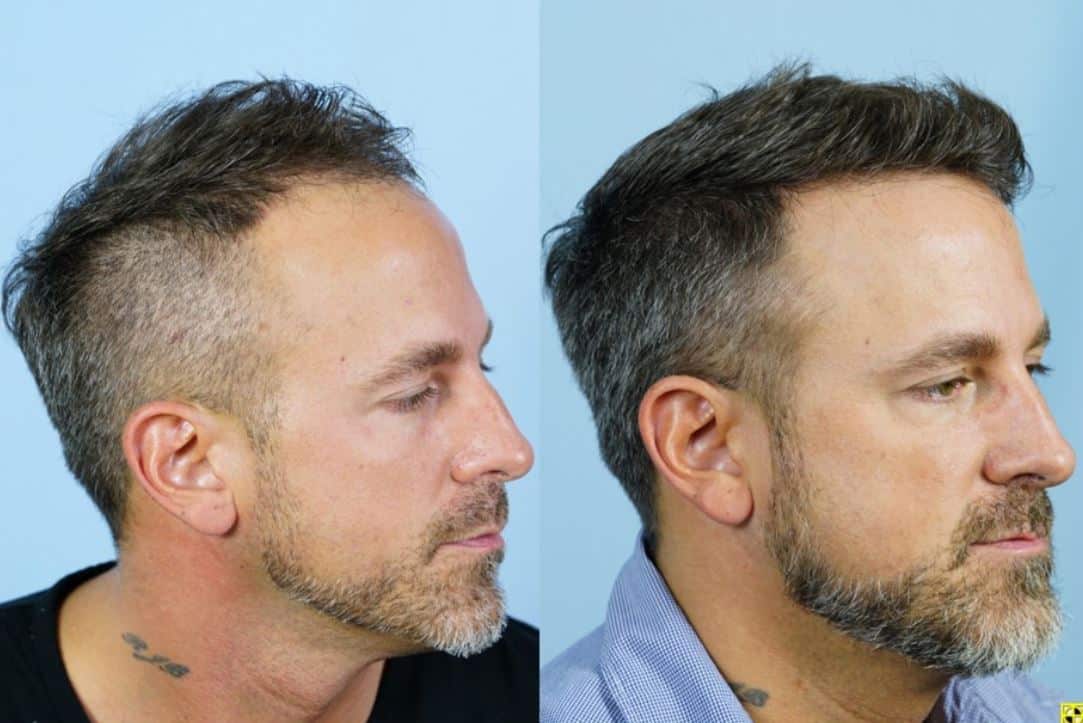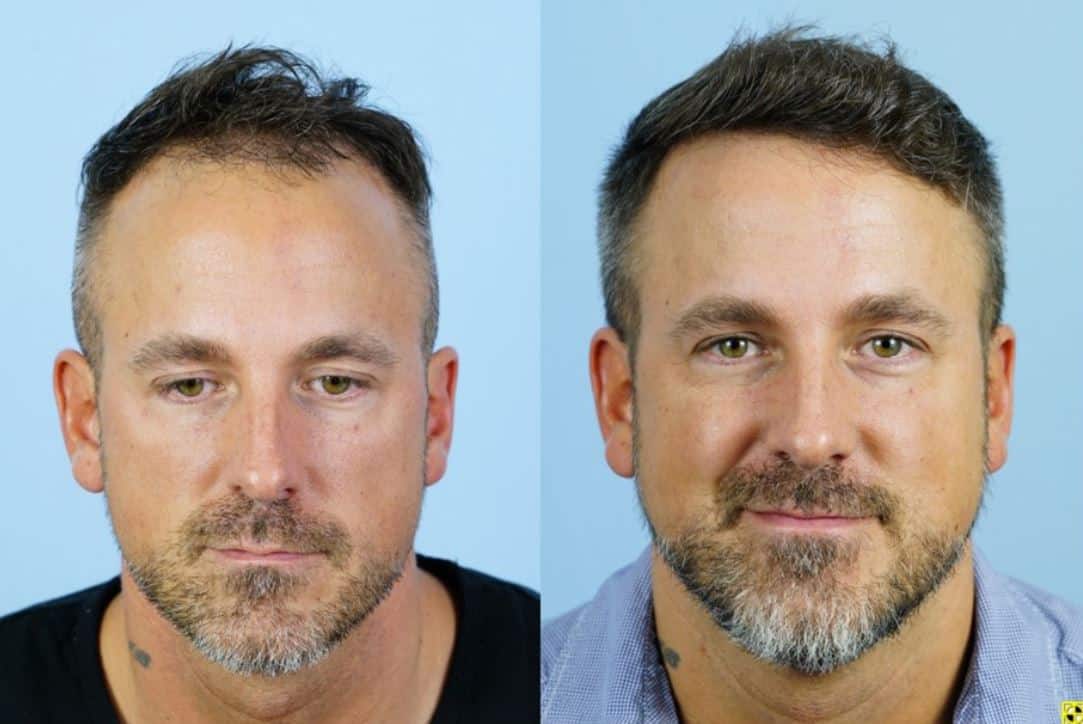What Is FUE Hair Transplant?
Follicular Unit Extraction (FUE) is a minimally invasive hair transplant technique that involves extracting individual follicular units directly from a donor area, typically the back of the scalp, and implanting them into balding or thinning areas. This method is particularly beneficial for those looking to:
- Avoid linear scarring
- Create a natural-looking hairline
- Maintain the hair density of the donor area
- Receive permanent results (like in FUT method)
- Have a less invasive procedure with quicker recovery times compared to strip FUT hair transplant surgery
During FUE hair transplant procedures, each graft is harvested individually with a small micro punch (0.7 mm to 1.0 mm in diameter). This device makes a small circular incision around the upper part of the hair follicle, which is then extracted, leaving a tiny hole in the scalp. This is repeated until the surgeon has enough grafts to complete the procedure. With this approach, the linear scarring you’d typically see from strip FUT hair transplant method is avoided.
What Makes Shapiro Medical Group FUE Hair Transplants Different
You will be under the care of leaders in the art and science of hair transplantation, ones who set the standard of the field. With Shapiro Medical Group FUE Hair Transplants, patients are under the care of industry experts offering:
- Improved hairline restoration results with the latest FUE hair transplant technology (like Hybrid Punch and Oscillation System) that gets more grafts with less scarring
- Bio-enhancement technologies to promote maximum hair growth such as:
- PRP Therapy
- ACell Therapy
- Liposomal ATP Therapy
- Low-Level Light Treatment for better postoperative healing
- Hair donor area management techniques for natural-looking results and hair regrowth in the spaces where grafts have been removed
Diagram of Graft Extraction in FUE
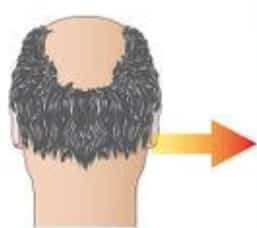
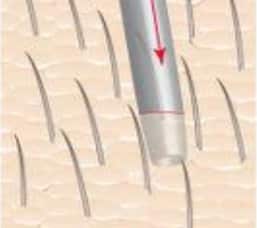
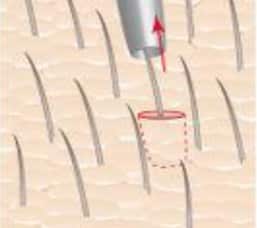
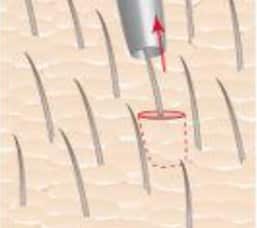
A&B show scoring of follicular unite with micro-punch. Figure C shows removal of follicular unit with forceps.
Photo Showing Graft Extraction with Micro Punch in FUE
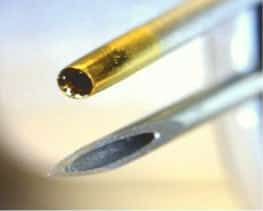
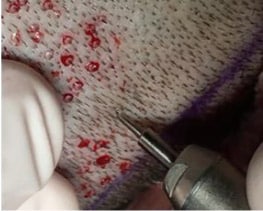
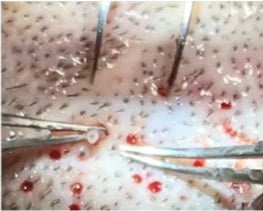
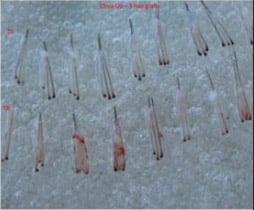
FUE does not leave a linear scar in the donor area, which is an important advantage for patients who prefer shorter hairstyles. Post-operative discomfort is also reduced, and the donor area heals more quickly.
Excellent Healing and No Linear Scar 1 Week Post-Op
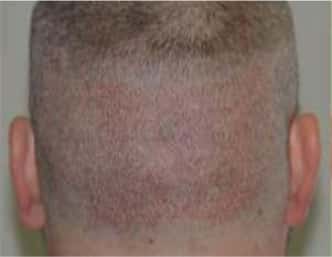
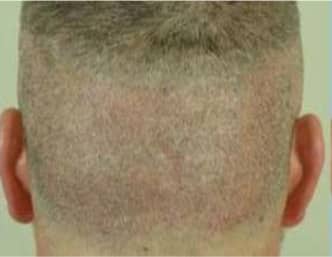
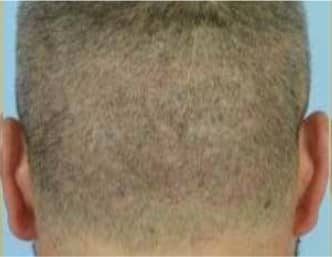
Both strip FUT and FUE techniques have their own advantages and disadvantages, and in many cases, a combination of techniques works best. SMG’s expertise with both techniques enables our physicians to work with each patient to help them choose the best approach for their particular goals. This is part of the Shapiro Medical experience.
Example SMG FUE Patient #1
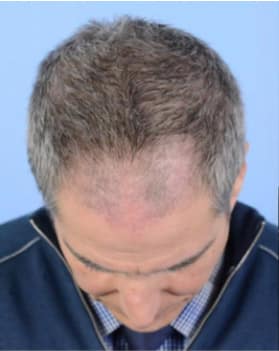
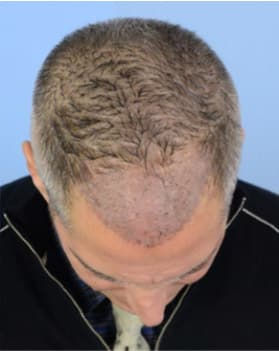
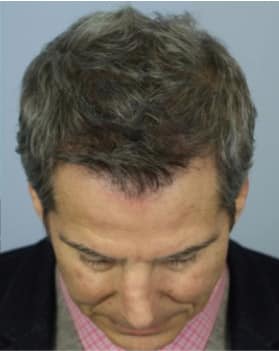


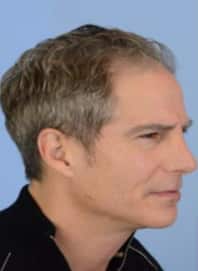
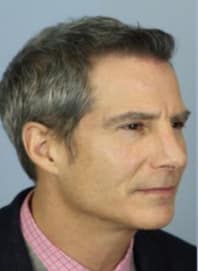
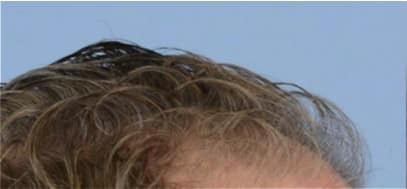

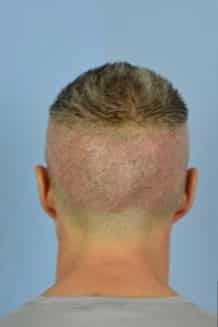
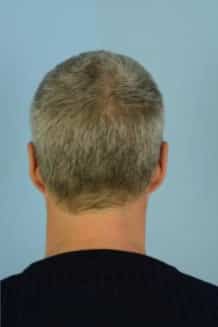
HOW FUE HAIR TRANSPLANT IS DONE
STATE OF THE ART HYBRID PUNCH AND OSCILLATION SYSTEM FOR IMPROVED HAIR GRAFT RESULTS
At Shapiro Medical Group (SMG), we use the Hybrid Punch and Oscillation System for FUE extraction to help us deliver better results for our patients. The two main components of this technique are:
- Using a hybrid flat punch instead of a sharp punch helps reduce damage and collect grafts with more protective tissue, improving graft yield. The hybrid punch has a flat front surface and cutting edges on the outside, pointed away from the hair.
- A motorized system that produces variable-speed oscillation instead of constant one-way rotation to mimic the accuracy, sensitivity and control of a punch being held by a human hand. A highly sensitive foot pedal enables control over oscillation speed and arc.
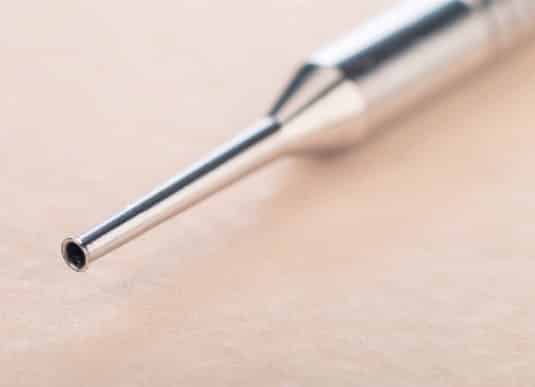
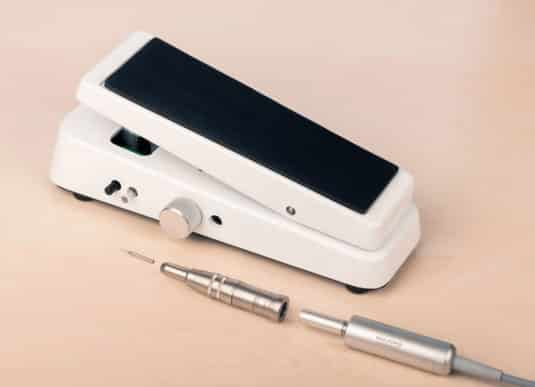
This amazing advance was developed by Dr. Shapiro’s good friend, Dr Jean Deveroye in Belgium and we are proud to say that Shapiro Medical Group was one of the first clinics to use this device. Since then, hundreds of clinics have switched over to it.
Before the development of the Hybrid System there was much controversy and debate over what FUE hair transplant technique was the best. Much of the controversy centered around the differences between:
1) Sharp Punch Vs Dull Punch Technique; and
2) Manual Vs Motorized Technique.
Each FUE hair transplant technique has its strengths and weaknesses. The beauty of the Hybrid Punch and Oscillation System is that it combines the best features of all these techniques while eliminating their weaknesses. At Shapiro Medical Group, you will be in the care of leading hair transplant innovators who will help you achieve hairline restoration by using the latest techniques proven to deliver improved outcomes.
BENEFITS OF THE HYBRID PUNCH FUE DEVICE
Hybrid punch FUE hair transplant is an innovative method proven to outperform other FUE devices. It offers the following advantages over standard FUE hair transplants:
- Hybrid punch FUE uses the power of sharp punches to easily penetrate the top layer of skin without distorting grafts. The thin wall and fast oscillation provide the cutting power of sharp punches. However, unlike sharp punches, it reduces the risk of transection (damage to the hair grafts) when the oscillation slows down and the punch goes deeper, allowing for healthier grafts with more tissue.
- It utilizes the benefits of blunt tip punches to limit transection. The flat, smooth tip of the Hybrid Punch allows the punch to go deeper without increasing the risk of damaging grafts, producing healthier grafts with more protective tissue around the follicle.
- It leverages the precision of manual techniques. The manual technique uses a slow oscillation movement to give the best feel and control while extracting grafts. This is the same movement used with the Hybrid Punch and Oscillation System but without the fatigue experienced by manual systems.
- It uses motorized techniques for easier alignment with hairs. The motorized oscillation keeps the punch aligned with the hairs, allowing the physician to focus on direction and alignment rather than the tricky rotational movement. This reduces fatigue and increases speed and accuracy.
At the 2015 Mediterranean FUE Workshop in Istanbul, Turkey, this system outperformed all other FUE devices, producing healthier follicular unit grafts with a higher survival rate. We believe the Hybrid Punch and Oscillation System will soon become the preferred technique for most surgeons.
Shapiro Medical Group is one of the first hair transplant clinics in the world to master this procedure. Our physicians have been invited to speak about it at FUE hair transplant conferences worldwide.
FUE HAIR TRANSPLANTATION STEPS AT SHAPIRO MEDICAL GROUP
Shapiro Medical Group is one of the first hair transplant clinics in the world to master this procedure. Our physicians have been invited to speak about it at FUE hair transplant conferences worldwide.
Identifying Donor and Recipient Areas for Hair Transplantation
Before the actual operation starts, experts will outline donor and recipient areas where the grafts will be harvested and placed. This determines the ideal hairline design and getting the approval of the patient for the hair transplantation areas.
Administering Anesthetic
To ensure patient comfort, anesthesia will be administered to numb the scalp to make the hair graft harvesting and placing process as painless as possible.
Preparing Recipient Areas
A few grafts will be harvested from the donor area to test if they fit the recipient site. When this has been confirmed, the surgeon will commence making the necessary recipient sites for the grafts.
Harvesting Hair Grafts
The hair grafts will be harvested according to the number of recipient sites made. This is dependent on the patient’s hairline restoration goals. With Shapiro Medical Group innovations in FUE hair transplantation like the Hybrid Punch, more grafts can be harvested with less scarring and improved outcomes.
Placing Hair Grafts
The extracted hair grafts will then be planted into the recipient sites in the ideal angles and orientations. This is done to restore the specific area’s hairline and pattern in a natural looking way to meet the patient’s aesthetic specifications.
This process is both a science and an art that has been refined at Shapiro Medical Group. Our team of industry-leading experts utilizes the latest technology combined with their decades long experience to deliver results that will be satisfactory for our patients.
FUE Hair Transplant Recovery
Shapiro Medical Group utilizes a variety of cutting edge methods to promote our patients’ hair transplant recovery process, decrease discomfort, and improve hair graft results and recovery while reducing scarring.
FUE & BIO-ENHANCEMENT TECHNOLOGY FOR IMPROVED RESULTS AND RECOVERY
At Shapiro Medical Group, we use bio-enhancement technological breakthroughs to get maximum growth from an FUE hair transplant procedure. It includes using:
- PRP/ACell Therapy to improve hair growth, survival, and healing.
- Liposomal ATP Therapy to supply the grafts with life-giving energy during and after surgery while they are re-establishing their blood supply.
- Low-Level Light Treatment (laser) to promote post-operative healing and maximum growth.
Example SMG FUE Patient #2
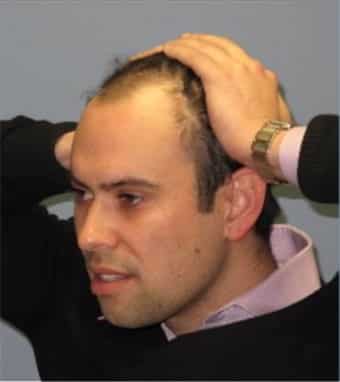
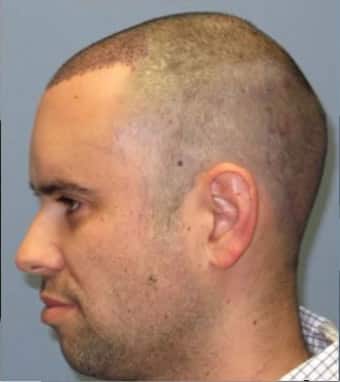
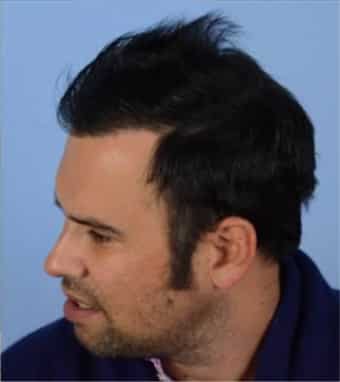
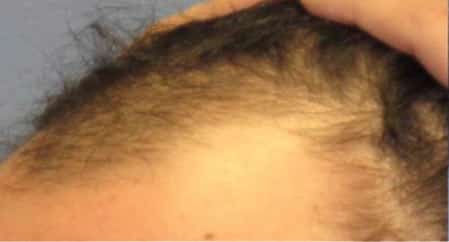
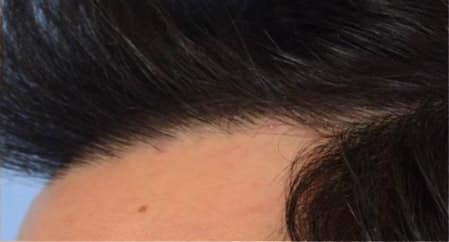
ADVANCED DONOR MANAGEMENT
One of the biggest challenges with FUE hair transplant is obtaining a large number of grafts without depleting the donor area or making it look unnatural. Shapiro Medical Group hair transplant experts address this with several advanced techniques, including:
- Selective hair transplant donor harvesting or splitting the more complex, larger follicular units to leave hair in the donor area.
- The use of PRP/ACell in the donor area to stimulate the regrowth of transected hairs or stems cells that may have been left behind
- The use of scalp micropigmentation to fill in the spaces in the donor area caused by higher numbers of grafts removed by FUE.
ADVANTAGES OF FUE HAIR TRANSPLANTS
ADVANTAGES OF FUE HAIR TRANSPLANTS
The main advantage of choosing a FUE hair transplant is that it does not create linear scars, only tiny ‘dot-like’ scars that are almost unnoticeable. FUE also results in a more gentle postoperative recovery with quicker healing of the donor area.
FUE hair transplants are a good choice for the following patients:
- Patients who wear their hair very short (< 1 cm) and want to have less of a visible scar.
In longer-haired patients, the linear scars produced with traditional strip FUT are thin and easily hidden by the remaining donor hair. With FUE, the donor area scar is virtually undetectable at hair lengths of less than 1 cm (if punches less than 0.9 mm are used and fewer than 5,000 grafts have been harvested). Although the risk of visible scarring is less with FUE, a shaved head may make the small white dots noticeable.
- Patients who want a less painful and quicker healing postoperative recovery in the donor area.
It takes longer for a strip incision to heal, and there are physical limitations put on a patient after a strip FUT hair transplant procedure that may last up to a month. In contrast, the donor area is virtually healed with an FUE hair transplant surgery, and there are no limitations within a week or two after surgery.
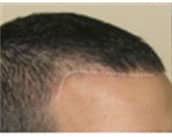
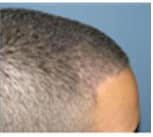
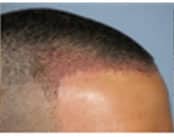
POTENTIAL DISADVANTAGES OF FUE HAIR TRANSPLANTS
-
Graft transection.
When FUE hair transplant surgeries first began, the incidence and degree of graft transection were high. High graft transection means an increased risk of lower graft yield. Fortunately, with improved techniques like the Hybrid Punch with Oscillation and experience, the transection rate can be less than 2 to 5%, similar to the strip method.
However, the potential for high transection still exists in inexperienced hands, especially for patients with difficult characteristics like very curly hair or mushy skin.
-
Fragile grafts.
Until recently, the grafts from FUE grafts were typically thinner and stripped of more protective tissue than FUT grafts, making them more fragile and susceptible to decreased yield. However, with the use of flat punches to obtain chubbier grafts and bio-enhancement techniques, the yield between FUE and strip FUT hair transplants is narrowing and can be the same.
-
The limited number of grafts available over the lifetime of the patient.
Most hair transplant surgeons believe that more grafts can be harvested over the lifetime of the patient with strip FUT hair transplant surgery than with the exclusive use of FUE. This problem may not apply to patients who need a lower number of grafts (4,000 to 5,000) or are early in their hair-loss journey.
To compensate for the inability to harvest all the hair from the permanent zone, many FUE hair transplant surgeons harvest hair from the upper and lower margins of the original donor area and risk the hair being of poor quality or being non-permanent.
Despite this limitation, the number of grafts obtainable from FUE hair transplants is increasing with new hair transplant innovations for graft harvesting and donor management and with the use of bio-enhancement products such as PRP/ACell to stimulate new hair growth.
-
Scarring.
Although a FUE hair transplant does not produce a linear scar, it does cause thousands of tiny punch scars and in some patients a “moth eaten” scar pattern can occur. This is less likely if a punch size of .9 mm or less is used and if the total number of grafts is less than 5,000. Applying PRP/ACell treatment in the donor area and selective harvesting may also limit this problem.
-
The need to shave the entire donor area.
The FUE hair transplant procedure requires that the entire donor area be shaved. For some patients, this is an aesthetic concern.
At Shapiro Medical Group, you can choose from a variety of hair restoration options available at our state-of-the-art facility in our Minneapolis hair transplant clinic. To know the best hair loss solution for you, schedule a consultation with our doctors today and start your journey to hair confidence.
WHO ARE GOOD CANDIDATES FOR FUE?
Generally, FUE hair transplant is suitable for young individuals (around 30-45 yrs. old), with minor hair loss, and prefer to wear their hair short.
Other good candidates for FUE also include:
- Patients with limited scalp laxity.
Patients who have had multiple strip harvesting procedures and now have a tight scalp that would make further strip harvesting difficult. FUE hair transplants can be used to obtain additional grafts from the scalp, beard and body without creating unnecessary risk on the donor scar.
- Patients who need a hair transplant repair.
Patients who have a widened linear donor scar from a prior hair transplant procedure can use FUE to obtain hair to camouflage this scar.
- Young patients with uncertain future hair loss.
Young patients who currently need only a small amount of grafts, like in the hairline, but are unsure about their future hair loss, can benefit from FUE hair transplants. Some of these patients prefer the flexibility to shave their head if they experience significant hair loss later on, instead of committing to more surgeries.
With FUE hair transplants, they have the option to stop after one or two small procedures and shave their head if needed.
FREQUENTLY ASKED QUESTIONS
How much does FUE hair transplant cost?
The cost of an FUE hair transplant varies based on your surgeon’s experience, the number of grafts you’ll need, and the location of your provider. It’s typically priced per graft, so getting a consultation to assess your hair loss will give you an accurate estimate.
Choosing hair transplant experts, especially those at Shapiro Medical Group, comes with the higher probability of achieving your desired aesthetic results. Though going to less experienced hair transplant surgeons might have a lower initial price, getting undesirable outcomes that lead to do overs or complications will be more costly in the long run.
Which hair transplant method is better? FUE or FUT?
The best hair transplant method for you depends on a lot of things, including:
- The extent of your hair loss
- Scarring preference
- Number of grafts needed
- Quality of your donor hair
- Budget
- Lifestyle preferences
FUE hair transplants offer minimal scarring and a natural-looking hairline, making it great for hairline reconstruction. On the other hand, FUT leaves a linear scar at the donor site but might be better for larger grafts or those with limited donor area. Consulting a qualified surgeon can help you choose the best method for you.
Can women get a FUE hair transplant?
Yes. FUE hair transplants are a great choice for women experiencing hair loss. It is a minimally invasive procedure that leaves minimal scarring, making it ideal for those who prefer shorter hairstyles. FUE also allows for transplanting smaller grafts, which can better address the diffuse thinning common in female hair loss. Still, you should consult a qualified surgeon if FUE is the right approach for you.
How long is the recovery for FUE?
The recovery time for FUE hair transplant is relatively quite short. Most patients can return to their normal activities within 1 to 2 days after the procedure. However, the scalp may take about 7 to 10 days to fully heal. Here’s a general timeline for recovery:
- First 1-2 Days: Rest and avoid strenuous activities. Mild swelling and discomfort are common.
- First Week: The donor and recipient areas will start to heal. Small scabs may form around the transplanted follicles and will typically fall off within 7-10 days.
- 2 Weeks: Most signs of the procedure, such as redness and scabbing, should be gone. Patients can usually resume their regular exercise routines.
- 1 Month: Hair shedding (shock loss) may occur, which is normal. New hair growth will start to become noticeable within 3-4 months.
- 6-12 Months: Full results will gradually become visible as the new hair grows and thickens.
RESTORE YOUR HAIRLINE WITH FUE HAIR TRANSPLANTS AT SHAPIRO MEDICAL GROUP
Miss your old thick hairline? The Most Trusted Name in Hair Transplantation will help you achieve a total hairline transformation. With the perfect blend of art and science and the latest in FUE hair transplantation technology, achieve natural-looking hairline restoration results with minimal scarring at Shapiro Medical Group.
At our Minneapolis hair transplant clinic, you can count on our team of Board Certified Hair Transplantation Specialists with world-leading industry experience and 25 years of undeniable results.
Practicing Hair Transplantation Since 1990, trust that you are in the best hands possible at Shapiro Medical Group.
FUE BEFORE AND AFTER PHOTOS
